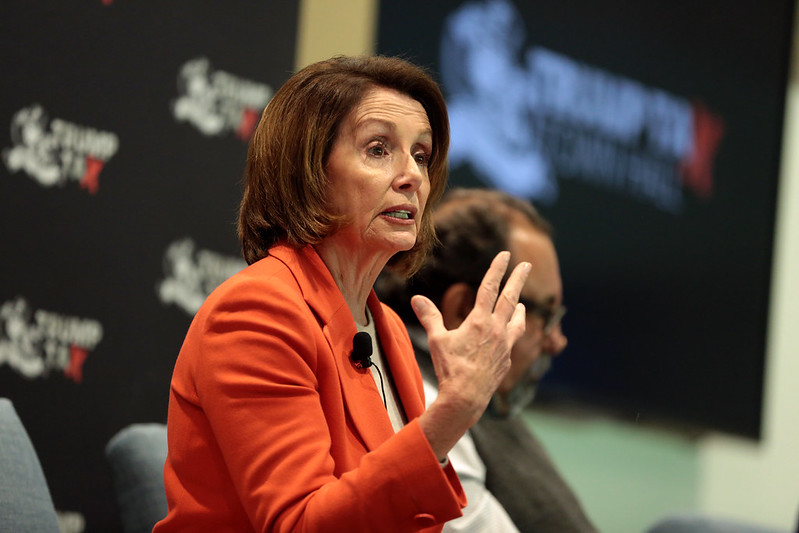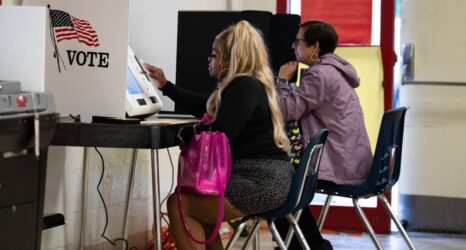To change things at the ballot box, we first must know where we really stand both at home and in comparison to women in industrialized countries with economies and governments similar to our own.

It’s just days until Election Day, and women’s votes are more crucial this year than ever. We must have not only the will, but also a firm grasp of what we need to hold candidates at all levels accountable for policies that work toward social justice and equity for women.
What’s at Stake is a new bi-weekly series of abbreviated excepts from Ms. money editor Martha Burk’s book “Your Voice, Your Vote 2020-2021.” Using an intersectional approach of gender, race and class to issues ranging from health care to Social Security, violence, pay equity, LGBTQ rights, reproductive rights, the ERA and everything in between, Your Voice, Your Vote is a must for arming activists with the facts for meaningful change. A signed copy benefiting Ms. can be ordered here.
There is no question that women in the United States—whether rich, poor or in between—enjoy a relatively high standard of living compared to many women worldwide. But among developed nations, we’re far from “number one.”
To change things at the ballot box, we first have to know where we really stand both at home and in comparison to women in industrialized countries with economies and governments similar to our own.
The Global Gender Gap Index benchmarks gender gaps in 149 countries on economic, political, education and health-based criteria. We rank 53rd—behind such countries as Bangladesh and Bulgaria.
We’ve been steadily dropping for a decade—we were 17th in 2011, just nine years ago.
And we’re way behind the top four—Iceland, Norway, Sweden and Finland. Our neighbor to the north (Canada) ranks 19th, and Mexico to our south is 25th.
On the plus side, we’ve closed 76 percent of our overall gender gap in economic participation and opportunity, ranking 26th, and we’re 34th in educational attainment.
But we drop to 70th when it comes to health and survival, and we’re way down at number 86th in political leadership.
Challenges, to be sure. But also opportunities for forward progress.
Find a snapshot below (explore many other issues here), and support only candidates dedicated to the change we need. Remember: Women can control any election—we’re the majority of the population, of registered voters, and of those who actually show up at the polls.
Constitutional Rights

- Women do not have equal rights with men under the United States Constitution. The World Policy Analysis Center reports that in countries around the world with constitutions, 85 percent have explicit guarantees for gender equality. Only 15 percent (approximately 32 countries) do not, and one of these is the United States.
- Most individual countries in Europe have formalized equal rights for women in their constitutions, and Japanese women have had equal constitutional rights since 1946.
Political Participation
- After a record number of women were elected to the House in the 2018 midterm elections, the U.S. ranked 75th in the world in the number of women in Congress (down from 69th in 2011), with 23.5 percent of the total seats. By contrast, among highly developed countries, Sweden was at the top, with women making up 46.1 percent of Parliament.
- There are currently 13 female prime ministers or presidents worldwide. The United States has never had a female president, vice president, chief justice or Senate majority leader. The first female speaker of the House of Representatives (Nancy Pelosi) was elected in 2006.

Earnings and the Pay Gap
- According to U.S. Census Bureau figures for full–time, year–round workers, women’s earnings for 2018 are on average 80 percent of men’s. The gap has been virtually the same for over a decade. By contrast, women in Australia, Belgium, Italy and Sweden reached 80 percent as early as 2003.
- Earnings for women of color continue to be lower than those for white women, who earn 79 percent of men’s wages overall. Asian American women make 90 percent, African American women come in at 62 percent of men’s earnings, and for Native American women it’s 57 percent. Latinas are at the bottom with only 54 percent.
Access to Paid Leave at Work
- In the U.S. there is no legal right to sick leave, maternity leave or paid family leave. This puts us in stark contrast to other nations—145 countries provide for paid sick leave, and more than 50 countries offer six months or more of paid maternity leave, many offering paid paternal leave as well. Out of 193 countries in the United Nations, only a handful do not have national paid parental leave: New Guinea, Suriname, a few South Pacific island nations, and the United States.
Higher Education
- Women now outnumber men in college enrollments, but they remain segregated by college major. Nine of the 10 highest-paying majors are male-dominated, while six of the 10 lowest-paying majors are female-dominated.
- Women hold almost two-thirds of the country’s $1.4-trillion student debt, and the student loan gender gap has nearly doubled since 2014.
- The most common job for women majoring in engineering, computer science, economics, chemistry and business remains: a K-12 teacher.
Child Care
- Child care tends to be the first or second largest household expenditure, and U.S. parents pay almost all of their child care costs without state or federal assistance. Center-based care for two children in the U.S. can cost over 25 percent of a two parent family’s net income.
- Child-care costs can eat up 37 percent of a single parent’s household income.
- Many countries in Europe have some form of national child care, staffed by teachers paid good wages by the national governments.
Health Care
- Almost one in five women in the U.S. lacked health insurance in 2009, before passage of the Affordable Care Act (ACA) in 2010. The numbers were miserable when broken down by race:
- 25 percent of African American women were without insurance,
- 30.5 percent of Native American women, and
- a whopping 40 percent of Hispanic women were not covered.
In 2015, after passage of the ACA, that uninsured rate among women declined immediately, resulting in 7.7 million women gaining coverage, according to a report by the Department of Health and Human Services. An estimated 55 million women are also gained coverage for preventive services with no out-of-pocket costs. (This report has since been removed from the HHS website.)
- The Trump administration has sued to overturn the Affordable Care Act. The Supreme Court will hear arguments on November 10. The newest Justice Amy Coney Barrett has expressed her doubts about the validity of the law.
- Virtually every country in Europe has universal health care, as do Australia, Canada and Japan.
Social Security
- In the United States, benefits are based on paid earnings of the worker (or spouse if the spouse’s income is higher). But unlike the U.K. and France—just to name two—there is zero credit in the U.S. for time out of the workforce for caregiving.
Violence
- The federal Office of Violence Against Women has published no new information since the Trump administration took office. Nor has the Center for Disease Control conducted a new National Intimate Partner and Sexual Violence Survey. This is a travesty given that domestic violence has skyrocketed with the COVID-19 pandemic.
Bottom line: Women can control any election. Say it, know it, do it.
You may also like:





